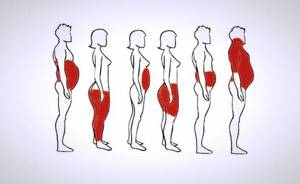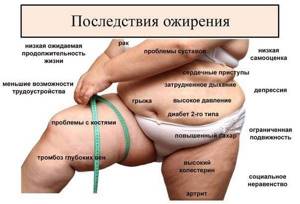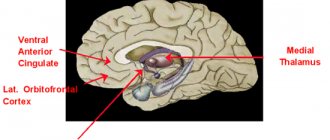Causes
Obesity begins to develop due to the discrepancy between the amount of energy consumed and expended. An imbalance arises. A person consumes such an amount of food that the body simply cannot process all the energy that comes with it. As a result, surpluses accumulate.
Also, the development of obesity is promoted by physical inactivity - a violation of body functions with limited physical activity, as a result of which the strength of muscle contraction also decreases.
Of course, the key reason is poor nutrition and regular consumption of harmful products.
However, another cause of obesity may be genetic predisposition. In people whose ancestors suffered from this disease for generations, the genes responsible for regulating body weight are simply deformed. And obesity becomes a genetic unpleasant feature.
Also, its occurrence is provoked by disturbances in the functioning of the liver, pancreas, large and small intestines.
This is a short list of reasons. Now you can talk in more detail about the types of obesity and everything connected with them.
What causes obesity?
The main reason for the development of obesity is the discrepancy between the consumption and intake of calories in the human body. It is unspent energy that is transformed into subcutaneous fat deposits and turns into extra pounds.
Doctors identify the following factors that provoke obesity in women:
- Disturbances in the functioning of the endocrine system.
- Hormonal imbalances.
- Recent pregnancy and childbirth.
- The onset of menopause.
- Sedentary lifestyle, low levels of physical activity.
- Slowdown of metabolic processes due to age-related changes.
- Breastfeeding.
- Depressive states.
- Frequent stressful situations, psycho-emotional shocks, leading to metabolic disorders and the formation of bad eating habits.
- Excessive appetite and tendency to overeat.
- Abuse of sweets, baked goods, fast food, fatty and fried foods.
- Genetic predisposition.
- Chronic lack of sleep.
- Diseases of the central nervous system, with concomitant damage to the brain centers responsible for eating behavior.
Long-term, uncontrolled use of antidepressants and hormonal drugs (including oral contraceptives) can also lead to the development of obesity.
How to determine the presence of surplus
Very simple. By calculating body mass index, to be more precise. To do this, you need to divide your weight in kilograms by your height squared (in meters). It is not difficult. With a height of 162 centimeters and a weight of 63 kilograms, the body mass index is calculated as follows: BMI = 63: (1.62x1.62) = 24.005.
The resulting value allows you to evaluate how much a person’s weight corresponds to his height, and determine whether it is insufficient, normal or excessive. By the way, it is BMI that is taken into account when determining indications for treatment, prescribing dosages of drugs, etc.
But BMI is not applicable in some cases. With its help, it is impossible to assess the physique of bodybuilders, athletes and other athletes, since they have well-developed muscles and minimal fat content.
Stages of treatment
If a woman is obese, she is prescribed diagnosis and treatment. To determine the degree of obesity, body mass index (BMI), body obesity index (BAI), and types of obesity are calculated.
Analyzes
Be sure to conduct laboratory research and get tested. The doctor will order blood tests for sugar and cholesterol levels.
Be sure to prescribe tests for thyroid hormones - thyroxine, triiodothyronine and thyrotropin. It is also important to test the blood for prolactin; perhaps a woman’s infertility lies in the deviation of this hormone from the norm.
Abdominal obesity can occur when the male hormone called testosterone is low, so testing for its presence and blood levels will be helpful. Depending on the test results and the degree of the disease, the doctor prescribes treatment.
Diet, exercise
For all types of obesity , special diets and sports exercises are prescribed, aimed at the entire body as a whole and at problem areas, for example, the abdomen. Drug treatment must be prescribed.
In case of hormonal obesity, if there are testosterone deviations from the norm, a diet is prescribed where the restriction includes protein foods. If these are the degrees of obesity at which endocrine system disorders occur, then a diet with sugar restriction will be prescribed.
A daily routine of active sports, a swimming pool and daily walks will become an obligatory part of the life of an obese patient.
In case of obesity due to a genetic factor , a diet is also selected; the Doctor will definitely tell you about the correct nutritional culture, prescribe exercise, and prescribe the woman medications that reduce the feeling of hunger. Although it is very difficult to fight genetic obesity, since the factor of abnormal life activity, instilled from childhood, is added.

In order not to bring the disease to a more severe degree, a woman can rebuild herself psychologically and her diet in a direction that is positive for health. Try to replace high-calorie foods with healthy vegetables and fruits. Replace large portions of food with small ones. You may not be able to lose weight to your desired weight, but stopping fat growth is quite possible. This way, many complications will be avoided.
Drugs
Drug treatment: drugs are prescribed that either reduce the hormone or increase it. Depending on the level, its balance is restored. To treat female obesity, which is caused by poor nutrition and lack of exercise, therapy is used, as for genetic obesity. In addition to drug treatment, a nutritionist can refer a woman to a psychologist, as this is an integral part of therapy.
Consultation with a psychologist
Mostly, women begin to gain weight due to a poor psychological microclimate, which is facilitated by loneliness or separation from their spouse. In these cases, food for a woman serves as a substitute for joyful emotions. A diet prescribed by a doctor can cause even more stress for a woman, so the problem of obesity must also be solved on a psychological level.
In cases where neither medications, nor sports, nor diets help, for obesity of 3 and 4 degrees, surgical treatment is used.
Liposuction
Liposuction, where fat accumulated under the skin is removed. Gastric banding, when a band is inserted into the stomach, thereby changing its shape. After surgery, a woman will definitely need a period of rehabilitation, which will be aimed at maintaining the woman’s psychological and emotional background, as well as establishing the right nutritional culture and lifestyle.
First degree manifestation
Least critical condition. Often occurs in childhood. For obesity type 1 (degree), the following BMI corresponds:
- From 28 to 30.9 for people over 25 years old.
- From 27.5 to 29.9 for those aged 18 to 25.
If you carry out simple calculations, you can understand that the first degree of obesity is height in centimeters, from which 100 is subtracted and 15 is added. Here, for example: BMI = 85 kg: (1.7mx1.7m) = 29.4. For clarity, rounded weight and height figures were taken.
So the maximum excess at the first degree is approximately 15 kg.

What does 1st degree obesity look like in women, photo
Obesity of the 1st degree in the fair sex can be avoided even before going to a specialist by critically examining the figure in the mirror.
The following signs will help recognize the disease:
- Increase in waist size up to 80 cm or more.
- Shapelessness and vagueness of the outlines of the figure.
- Swelling, to which the face, upper and lower extremities are most susceptible.
- An increase in the size of the abdomen (in case of abdominal obesity) or hips, buttocks (in case of hyoid type of disease).
In addition, representatives of the fairer sex with a progressive disease experience a change in eating behavior - they are more often than before overcome by a feeling of hunger; in order to feel full, a constant increase in portions is required.
In the absence of adequate, timely treatment, the disease will progress.
3rd degree obesity
This is already a serious pathology. Accumulations of fat exceed 50% of the mass, and BMI ranges from 35-36 to 40.9.
Characteristic signs include obvious excesses on the back, sides, abdomen and thighs. The muscles become completely weak, which is why neoplasms, umbilical and inguinal hernias appear. The joints and spine also weaken because they are subject to excessive stress. The result is constant pain.
The functioning of the digestive organs also changes; constipation, nausea, and even vomiting become common. Shortness of breath appears even after eating, swelling, fatigue and sweating are observed.
Treatment of third-degree obesity is a very long and difficult process. Weight is reduced gradually - in the first 5-6 months the loss should not be more than 10%.
The treatment complex includes physical activity, changing your diet and eating habits, taking medications, and visiting a cosmetologist. And, of course, food. For people with this disease, the limit is 1500 calories per day. And you only need to eat vegetables, lean meat and fish, greens, and unsweetened fruits. However, it is impossible to do without visiting a doctor, so each patient is prescribed an individual diet and treatment program.

Celiac obesity

This type of obesity is characterized by the accumulation of excess fat in the legs and thighs. Often, people with celiac obesity experience hormonal imbalances (for example, changes in hormonal levels during menopause).
To reduce its manifestations and moderate excess body weight gain, you need:
- Seek advice from an endocrinologist, he will conduct the necessary examination and prescribe tests for specific hormones.
- Stop being nervous and worrying about anything, because stress often causes hormonal imbalance.
- Stop smoking and drinking alcohol - they complicate hormonal correction prescribed by your doctor.
- Accustom yourself to regular physical activity, start leading an active lifestyle, which will “overload” your metabolism and help fight obesity.
Critical 4th degree
The most critical condition. This degree is characterized by excess weight twice or more. This stage is rare, as obese people simply do not live to reach it.
They cannot move - they only lie on the bed and sit, changing their position with someone's help. Shortness of breath torments them even at rest. And the body with the fourth degree of obesity resembles a shapeless mountain of fat. BMI, of course, is not calculated in such cases - it simply exceeds all acceptable standards.
There are cases where people with this degree of obesity have lost a lot of weight. Above is a photo of a British man named Paul Mason. He once went down in history as the fattest man on the planet. In 2013, he weighed 445 kilograms! It was the 4th type of obesity that the man had at that time. Paul said he was a prisoner of food. Every day I consumed kilograms of food.
But one day Paul fell in love with a woman from America who wrote to him after reading a story about him in the media. He decided to lose weight to be with her. And he achieved it! Two long years of daily exhausting training, special diets, and Paul lost as much as 300 kilograms! The consequence was whole layers of sagging, stretched skin. It had to be removed. The operation lasted 9 hours. Paul had 21 kilograms of excess skin removed.
So it’s possible to lose weight, even if you weigh almost half a ton, but it’s absolutely not recommended to go that far. There will be consequences, and they will cause irreparable harm to the body.
Obesity: causes
Most often, excess weight is caused not by one reason, but by several factors simultaneously. Predisposition to obesity may be genetic, but it should not be considered the only cause. Inactivity and poor nutrition often play a role here. In addition, sometimes there is a gene defect that leads to a lack of satiety. Obesity can begin in childhood, when food is used to cope with stress and rewards always consist of a lot of sweets. In addition, sleep problems can lead to such severe metabolic disorders that those affected are constantly hungry and cannot curb their appetite, although the body is not starving.
Eating disorders are the same cause as hormonal diseases, for example in the form of Cushing's syndrome (a hormonal disorder caused by excess cortisol). Medicines such as glucocorticoids, antipsychotics, some antidepressants and antidiabetics are also responsible for the development of obesity.
In addition, the first stone in the foundation of obesity can be laid in childhood. Inherited diseases, such as disorders of the pituitary gland, thyroid gland or adrenal cortex, can lead to various symptoms and weight gain. But nutrition in childhood also plays a significant role. Sitting at a computer, tablet or in front of the TV for many hours, lack of exercise and, moreover, eating the wrong, too fatty and too sweet food usually does not remain without consequences.
Families with obese children often have at least one overweight parent. The importance of food is an important component in a child's life. Possible reward rituals with sweets and the predominantly fatty composition of food, combined with inactivity, contribute to the occurrence of excess body weight. However, stressful situations, such as separation from parents or feeling “unloved”, can also lead to the consumption of the wrong, high-calorie foods.
Gynoid type
The distribution of deposits is one of the key criteria by which the type of obesity is determined. Well, in this case the classification is simple. Based on the type of deposit distribution, only three types of obesity are distinguished. And the first one is gynoid.
Characteristic mainly for women. It is an accumulation of fat on the legs, thighs and buttocks. This type of obesity in women is not uncommon, especially among those with a pear-shaped (guitar) figure.
Owners of such a structure can literally tighten and get rid of excess arms, pectoral muscles, and stomach in just a couple of months, but they will have to work for a very long time on the hips, from which deposits will disappear extremely slowly.
Doctors say that the reason lies in the increased production of female hormones. Be that as it may, fighting this type of obesity is not easy. You need to eat right, exercise actively, run or bike extra, and also drink water, give up trans fats, junk foods, white sugar, and eat small portions maximum 5 times a day.

Obesity of inactivity
This problem usually catches former athletes and fitness leaders by surprise, who trained for a long time, and then gave up training and began to lead a passive lifestyle. They walk little, prefer sedentary work, and rarely have active hobbies. Therefore, they have a large belly against the background of slight fullness in the rest of the body.
To reduce the symptoms of obesity and inactivity, you need to:
- Limit the amount of simple carbohydrates and sweets to a minimum, replacing them with complex carbohydrates: vegetables, fruits, berries, dried fruits, whole grain bread.
- Switch to fractional meals in small portions to reduce the risk of overeating at main meals.
- Return to an active lifestyle, starting with short but regular training, first at home, then in the gym.
- To love active games in the fresh air, to practice active pastime: cycling, roller skating, skating, rope park, trampolining, laser combat, kayaking, etc.
Android type
It is characteristic of men. Everyone is familiar with the concept of a beer belly, right? This is the android type of obesity. Deposits accumulate in the upper body, mainly on the stomach, armpits and chest.
And although gynoid obesity is not easy to fight, android obesity is more dangerous. Because fat is deposited in vital organs. Often, it is because of this that problems with blood pressure, the cardiovascular system, kidneys, liver begin, diabetes mellitus, infertility and impotence appear.
According to medical indications, if a woman’s waist circumference exceeds 80 cm, and a man’s is 94 cm, then the risk of android type obesity is high.
How to fight? Again, physical activity and normalization of nutrition. 40% of the diet should be for breakfast, 30% for lunch, 20% for dinner and 10% for snacks. In the morning – carbohydrates. Day and evening - lean food, vitamins, fermented milk products.
By the way, it is worth noting that male-type obesity also occurs in women. This shape is called an apple. Characteristic features: a weak or absent waist, a wide back and chest, round or flat buttocks, and the volumes of the bust, hips and shoulders are approximately equal. With obesity, everything is the same as in men - deposits are observed in the upper part. Legs can remain slender.

Obesity: consequences
People who are obese are more likely to have a number of potentially serious health problems, such as:
- Heart diseases,
- Apoplexy,
- High pressure,
- High cholesterol levels
- Diabetes mellitus type 2,
- Some types of cancer, such as: Cervical cancer,
- ovarian cancer
- Mammary cancer,
- bowel cancer,
- Esophageal carcinoma,
- Liver cancer,
- Gallbladder cancer
- Pancreas cancer,
- Kidney cancer
- Prostate cancer
- Depression,
High body weight in obesity affects metabolism and the musculoskeletal system, which can lead to various complications. These include insulin resistance, which often develops into type 2 diabetes, hypertension (high blood pressure), steatosis (fatty liver), joint problems, difficulty breathing, arteriosclerosis (calcification of the arteries) and fat metabolism disorders. Some obese patients already suffer from several of the secondary complications mentioned. Obesity increases your risk of cardiovascular disease such as heart attack or stroke, especially if your weight continues to increase.
In addition, recent studies have identified a mediator substance in abdominal fat (Wingless-type signaling pathway protein-1, abbreviated WISP1), which is released into the blood and promotes chronic inflammation and the development of insulin resistance. The more fat in the abdominal area, the more WISP1 is released.
Obesity and diabetes
In type 2 diabetes, the body is no longer able to transport stored sugar into cells. Insulin, which is also produced in sufficient quantities at the onset of the disease, is necessary for the utilization of sugar. When insulin resistance occurs, the body's cells no longer respond properly to insulin, meaning blood sugar levels rise and glucose does not get to where it is needed. The body then produces more and more insulin, and in the long term the pancreas reaches its limits and increasingly restricts insulin production. Type II diabetes occurs. The cause of this disease is often excessive body weight, that is, obesity, as well as poor diet and lack of exercise.

Excessive body weight leads to the development of type II diabetes. Photo: Peter Stanic/pixabay.com
Fat metabolism disorders
Other complications include a disorder of fat (lipid) metabolism, also called hyperlipidemia or hyperlipoproteinemia. Years of eating a high-fat diet can lead to increased levels of cholesterol and/or triglycerides in the blood. The excess can no longer be eliminated from the body and fat accumulates in the blood vessels, which can eventually lead to a heart attack or stroke.
Hypertension
High blood pressure, also known as hypertension, is one of the possible consequences of obesity. Due to severe excess weight, the body must be provided with a large amount of blood, which means there is a greater load on the heart. This increase in performance also increases blood pressure over time. However, there is definitely a possibility that by losing weight your blood pressure will return to normal.
Shortness of breath in obesity
Difficulty breathing is also one of the possible consequences of being overweight. Due to fat deposits in the rib area, breathing mobility is reduced. In addition, there is increased pressure in the abdominal cavity, which can cause the diaphragm to rise, further reducing tidal volume. Accordingly, shortness of breath appears. Most obese patients also suffer from what is called sleep apnea. This creates short pauses in breathing during sleep, which leads to daytime fatigue with reduced performance, even forcing you to fall asleep.
Musculoskeletal problems
The musculoskeletal system can also be affected by high body weight. Tendons, ligaments, muscles and joints are damaged. Back pain occurs. Painful arthrosis develops, especially in the knees and hips. Patients develop longitudinal and/or transverse flatfoot.
Gout
Due to predisposition, as well as obesity, a diet rich in purine and increased alcohol consumption, gout can occur. Uric acid is a breakdown product of purines. These substances are mainly found in animal products such as meat, sausage, some legumes such as lentils and beans, and alcohol. With a normal, balanced diet, the body usually deals with purines and excretes them as uric acid. However, if the food is very rich in purine, it can lead to excess uric acid in the blood and cause a gout attack. This is an inflammatory response, especially in the joints, that is associated with massive pain.
Painful periods
Female patients often complain of menstrual cramps. Reproductive capacity can also be affected by high body weight.
Mixed type
It is the most common of the existing ones. Characterized by an even distribution of fat throughout the body. It is deposited on the back, hips, arms, stomach, legs.
Why is this type of obesity dangerous? Because you might not even notice it. Due to the even distribution of excess, changes are not so obvious. So many people continue to live quietly, even after gaining 7-10 kilograms.
But sooner or later the jeans stop fitting, and you have to start fighting excess weight. The scheme is classic - three meals a day, two snacks, physical activity. And also regulation of water consumption. The fact is that this type of obesity is often associated with fluid retention in the body. And first of all, having started to lose weight and exercise, you will have to remove it - drain it. So you should drink 1.5-2 liters a day - this will be the norm.

How to treat stage 1 obesity in women?
Competent treatment of stage 1 obesity in women is a comprehensive program.
The therapeutic course includes the following:
- Taking medications.
- Treatment of concomitant pathologies that provoke excess weight gain.
- Diet therapy.
- Sports and physical therapy.
A systematic program requires changes in your eating style and lifestyle in general; only in this case can you achieve stable, pronounced positive results.
Diet: allowed and prohibited foods, menu for the day
Nutritionists highlight the following basic principles of proper, healthy nutrition for stage 1 obesity:
- Replacing sugar with sweeteners.
- Reducing the amount of salt in the daily diet to a minimum.
- Fractional meals (eating food in small portions, 5-6 times throughout the day).
- Increasing the diet of foods rich in dietary fiber and plant fiber.
- Maintaining a healthy diet and avoiding snacks between meals.
- Exclusion from the menu of fatty, fried, pureed dishes, baked goods, and sweets.
You will also have to monitor the caloric content of your diet, which should not exceed 1900 calories during the day.
In order to cope with obesity, you will have to give up the following foods:
- Fast food.
- Alcohol, carbonated drinks.
- Honey.
- Spices.
- Condensed milk.
- Pickled foods.
- Canned food.
- Pickles.
- Ice cream.
- Smoked meats.
- Sweet fruits and berries.
- Hot peppers.
- Pasta, baked goods made from 1st grade flour.
However, during a diet it is not at all necessary to starve and drink sparingly.
The list of permitted products includes the following:
- Lean meats.
- Fish and seafood.
- Whole grain cereals.
- Fresh, stewed or boiled vegetables.
- Vegetable oil.
- Fermented milk products.
- Berries, fruits with a sweet and sour taste, citrus fruits.
- Low-fat dairy products.
- Legumes.
- Black bread.
Drinks allowed include still mineral water, herbal teas, juices, and herbal infusions. It is very important to maintain a drinking regime, consuming at least 1.5 liters of liquid per day.
Nutritionists offer the following daily menu:
- Breakfast - oatmeal, boiled egg, black or green tea without sugar.
- Second breakfast - apple.
- Lunch - borscht, vegetable stew, a piece of boiled chicken. For dessert - juice or compote.
- Afternoon snack - a handful of nuts.
- Dinner - a portion of low-fat cottage cheese.
Before going to bed, you can allow yourself a glass of kefir or skim milk, an apple, or fruit juice.
Effective drugs
To combat obesity, doctors use the following categories of medications:
Drugs that increase energy expenditure:
- Adrenaline and various analogues.
- Products whose main active ingredients are thyroid hormones.
Drugs that suppress the feeling of year and stabilize appetite:
- Meridia.
- Sibutramine.
Drugs that activate metabolic processes:
- Agents that stimulate fat metabolism, as well as affecting the metabolism occurring in internal organs and tissue structures (preparations based on somatotropic hormone, testosterone).
- Medicines that help suppress the processes of food absorption in the gastrointestinal tract and reduce the absorption of fats from food (Xenical).
Fat burners are drugs that activate fat burning processes, help eliminate subcutaneous fat deposits and transform them into energy potential (Lipo 6, L-carnitine).
All drugs for the treatment of obesity must be prescribed by a specialist. Also, the doctor individually selects the optimal dosage of the medicine and the duration of the therapeutic course for the patient.
Physical activity
For effective treatment of stage 1 obesity, it is important to devote time to physical activity, gradually increasing the load.
It is recommended to start with morning exercises and race walking, at a speed of 60 steps for a minute. Every day the speed should be increased to 120 steps per minute.
Exercises such as bending, squats, jumping, abdominal swings, body turns will be effective, helping to strengthen the muscle corset, ligaments, spinal column, as well as eliminating subcutaneous fat deposits localized in problem areas.
It is imperative to include the following sports in your weight loss program:
- Swimming.
- Gymnastics.
- Running (recommended after 4-6 months of training).
- Fitness.
- Exercises in the gym.
A personal trainer or fitness instructor will help an obese woman develop an optimal training program, depending on the level of training, existing problems and the degree of their severity.
Treatment
After looking at photos of obesity types, calculating your BMI and discovering that you are overweight, you don’t need to delay correcting the situation. Even if the first degree is observed. You need to eat right, keep yourself in shape, engage in some kind of physical activity - this will not only ensure a pleasant appearance, but will also have a positive effect on your general condition, endurance and strength, and immunity.
Having neglected yourself, you will still have to start treatment when the body begins to give signals. But in this case you will have to set strict unusual limits for yourself and take a lot of medications - reducing appetite, stimulating energy consumption, affecting metabolism and many others.
Obesity treatment
The goal of obesity treatment is to achieve and maintain a healthy weight. Depending on the severity and condition of the disease, several treatment options are available, such as:
- change of diet,
- regular exercise
- behavioral changes,
- obesity treatment in a rehabilitation clinic,
- medicines such as orlistat or lorcaserin,
- intragastric balloon to reduce the size of the stomach,
- surgeries such as gastric bypass, gastric contraction, gastric banding.
Forms of obesity depending on the cause of the pathology
Primary (exogenous) or nutritional obesity is caused by lifestyle. Modern man eats a lot and moves little, and a violation of the normal ratio between incoming and expended calories inevitably leads to the accumulation of fat. How a person eats also matters, because the development of nutritional and constitutional obesity can be caused not so much by an abundant diet as by an unbalanced one, for example, with excess fat and carbohydrates, as well as erratic meals . Irregularity of nutrition with nutritional constitutional obesity (when fat is deposited under the skin, changing the contours of the body) is very common, and usually a person cannot understand why his weight is increasing, although he “doesn’t eat anything” all day, except for dinner... In addition, the primary form of the disease is caused by improper eating behavior, for example, abuse of fast food and the habit of “eating” stress, relieving psychological stress with food.
Secondary (organic, endogenous) obesity develops due to diseases of the internal organs of a person or is hereditary. With this form, people gain weight, despite consuming a reasonable amount of good quality food, and, as a rule, they fail to get rid of extra pounds without medical intervention. Moreover, we are talking not only about the help of nutritionists, but also about the participation in the process of specialized specialists - an endocrinologist and a gastroenterologist.

The following types of secondary obesity are distinguished:
- endocrine obesity , which is caused by diseases of the organs that produce hormones, that is, the thyroid gland (thyroid obesity), pituitary gland, adrenal glands, as well as the pancreas and gonads; treatment of this type of obesity is carried out comprehensively, and first of all, the patient’s hormonal levels are normalized;
- cerebral (brain) obesity, which is a complication after infectious diseases, injuries and brain tumors; a very serious pathology requiring equally serious treatment;
- medicinal obesity, which occurs as a result of taking, as a rule, hormonal drugs, for example, glucocorticoids and oral contraceptives, as well as antidepressants, especially if they are used uncontrollably by a person who is not actually suffering from depression.
Diet for obesity
To control excess weight, you need to change your diet. However, it cannot be changed abruptly, from today to tomorrow. Especially if you are overweight, medical supervision of your diet or dietary changes is mandatory. For pre-existing diseases, an accurate nutrition plan is drawn up so that deficiency situations do not arise. To lose weight if you are obese, your consumption of meat and sausage should be significantly limited. Protein needed by the body can also be consumed through low-fat dairy products or fish.
The amount of daily fat intake should not exceed one gram per kilogram of body weight. At the same time, it is also important to monitor hidden fats, which are found mainly in fast food and prepared foods. Prepared meals should be low in fat; the required fat is best consumed in the form of mono- and polyunsaturated fatty acids. In addition, you need to change the portion size so that energy intake exceeds energy supply.
There are no best diets for losing weight. The key to success is to permanently change your diet to a healthier one. The following points need to be considered when changing your diet:
- Set a calorie limit : You need to determine and stick to your daily calorie limit. Everyone can have their own. This is typically 1,200 to 1,500 calories for women and 1,500 to 1,800 calories for men.
- Hearty foods : Desserts, pastries, processed foods, chips and the like contain large amounts of calories in small portions. However, fruits and vegetables offer larger portions with fewer calories. This way you can eat your portion without consuming too many calories.
- Substituting unhealthy foods: Animal fats can be replaced with vegetables, white bread with whole grains, baked goods and sweets with fruits, red meat with poultry and fish, chips with potatoes or rice, etc.
- Reduce sugar: Avoid sweetening drinks. In general, tons of sugar is hidden in many processed foods. One example is breakfast cereal, which is promoted as a health food.
- Meal replacement: Breakfast, lunch, afternoon snack or dinner can also be replaced with special dietary products, such as a low-calorie vitamin shake. This is best done as part of a controlled diet. In this case, 5-6 meals a day are prescribed, excluding foods that stimulate the appetite (savory snacks, pickled vegetables, spices, etc.).
- Avoid Crash Diets: Weight loss should be slow and steady. Beware of diets that promise high weight loss in a short time. As a rule, all the lost kilograms and even more come back if a permanent change in diet is not achieved.











